#hercules vs angry crab
Photo
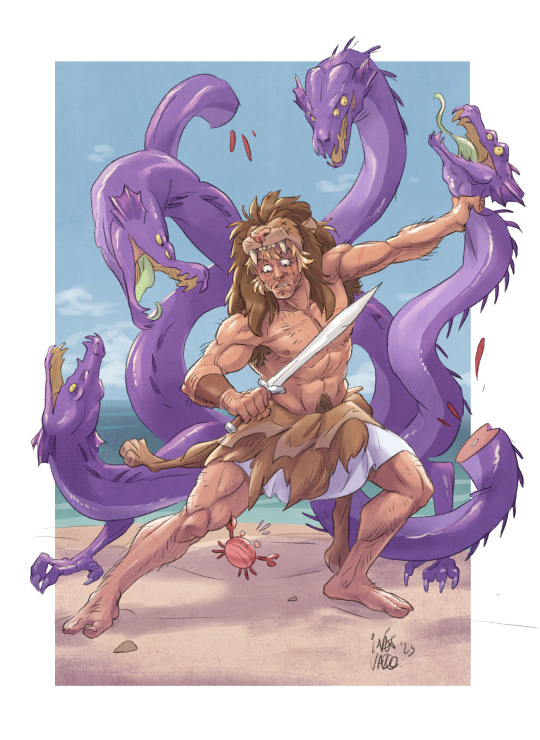
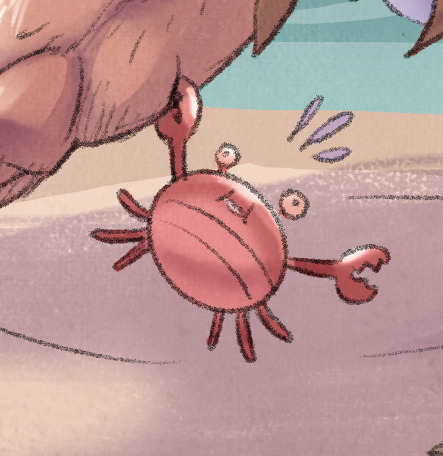

Let´s upload all the creatuanry stuff so far before january is over.
Day 1 Karkinos, also know as the crab that decided to do crab things when Hercules was doing Hercules stuff.
Heavely inspired by an ancient greece genious artist
#creatuanary 2023#creatuanary#karkinos#hercules#hercules vs angry crab#hydra#larnaean hydra#hercules vs hydra#monster#ancient greece#Greek Mythology#mythology#folklore#creature#creature design#illustration#drawing#digital drawing#crab#get off my leg#male anatomy
115 notes
·
View notes
Text
Hide & Seek references compendium
I put so many little easter eggs and hidden things in my Hide and Seek fic, so here is my little ongoing list of references I purposefully put in the fic for those of you who like this kind of thing idk man
Chapter 1, Disney's Hercules: "Hey, Mack! Ya wanna buy a sundial?" Disney's Jungle Cruise: “Trader Sam’s! Come shop at Trader Sam’s! He’ll give you a great deal on shrunken heads! Two of his heads for one of yours!” the Holmes Hotel, Hugh's Pies is a reference to Nickelodeon's Jimmy Neutron series, Lilo's Stitches and Embroidery is a nod to Disney's Lilo and Stitch, "Crusty the Crab" is a nod to Spongebob Squarepants, Chell's Portal Stop is a reference to the game series Portal, and the final scene is from the ROTTMNT episode "Hidden City's Most Wanted".
Though this is not technically a reference or Easter egg, I wanted to add this note… I made a point of referring to Splinter as Lou Jitsu when he was mad or angry or selfish, and as Hamato Yoshi when he was scared or sad.
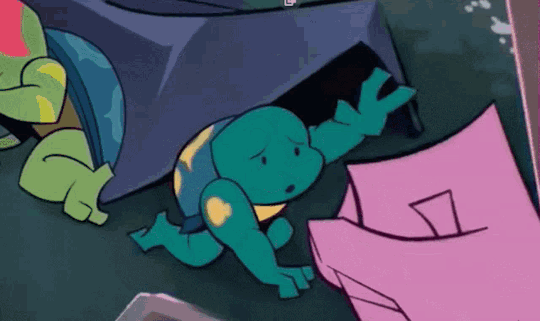
Chapter 2, Leo's determination to have Raph call him "the world's greatest ninja" is a reference to the film, Leo's quote "Land safely!" is taken from the episode "Mystic Mayhem" as well as the episode "The Evil League of Mutants", Leo's complaining to be leader is a nod to his future role, Raph referring to his father as a "sewer monster" is a reference to the episode "Man vs. Sewer", Splinter has a flashback from the episode "Goyles, Goyles, Goyles" and the line "OW! Why, you little--!" is also taken from that same episode.
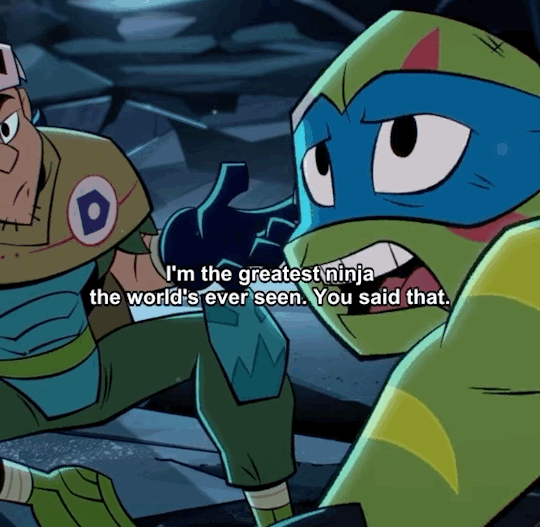

Chapter 3, Mikey's dream is obviously a nod to all that he will do in the future.
Chapter 4, The origin of Lace Face from the episode "Man vs. Sewer".
Chapter 5, Phineas and Ferb "Escape from Phineas Tower": "That's some mole!" The line "Raph! Your enormous body is crushing me!!” is a reference to Disney's Lilo and Stitch, "sweater town" is a reference to the Gravity Falls episode "The Hand that Rocks the Mabel", the line "I didn't want to believe it, but... *sigh* science." is taken directly from the ROTTMNT film as well as a moment when Leo mentions that Donnie was wrong, Donnie uses two really's, a reference from the episode "Breaking Purple", Donnie gives Leo the comic seen in the episode "Jupiter Jim Ahoy!"
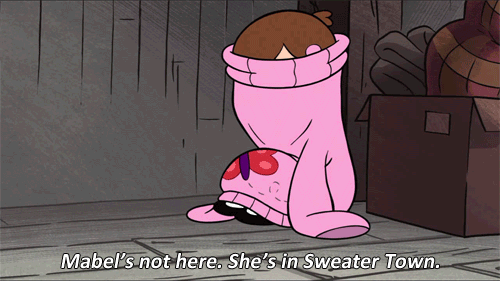
Chapter 6, Splinter's tv flips through several channels which include clips from media. These include a Thomas Sanders vine with "Weatherman Al", the quote "My leg!" from Spongebob Squarepants, part of the Fairly Odd Parents' theme song, Mrs. Cuddles' catchphrase "Let's be friends forever!", "I've got bad feeling about this" is a quote from Star Wars, the fake show about "Goosey" is an easter egg to @gooeseyleo and her Gooseyleo series. When Leo goes onstage, he does "a few improvised dance moves", which is a nod to Ben Schwartz and some dance moves he did in the Netflix improv comedy special "Middleditch and Schwartz”. The Lou Jitsu play the boys perform is a parody of the Godzilla franchise and the Pacific Rim films. Donnie's line "I strive for accuracy" is a reference to @sleepis4theweak 's comic (which I think about every gosh darn day), Horsebot-3000 and Splinter's line "I liked Horsebot-3000" are references to the show Community, season 3 episode 7: "Studies in Modern Movement".


Chapter 7, in the illustration Leo and Donnie are wearing Transformer and Decepticon t-shirts, respectively, and in the background you can see spray paint that spells out "Atomic Lass", as well as a drawing of the turtles' weapons.
Chapter 8, a young BEBOP AND ROCKSTEADY make an appearance, as does a very young Harvey Hokum from the ROTTMNT comics. When Bebop tries to sell Leo, he calls him “Shelly”, a reference to my pet turtle of the same name. In the illustration you can see a goldfish on the shelf, which is meant to be Piebald.
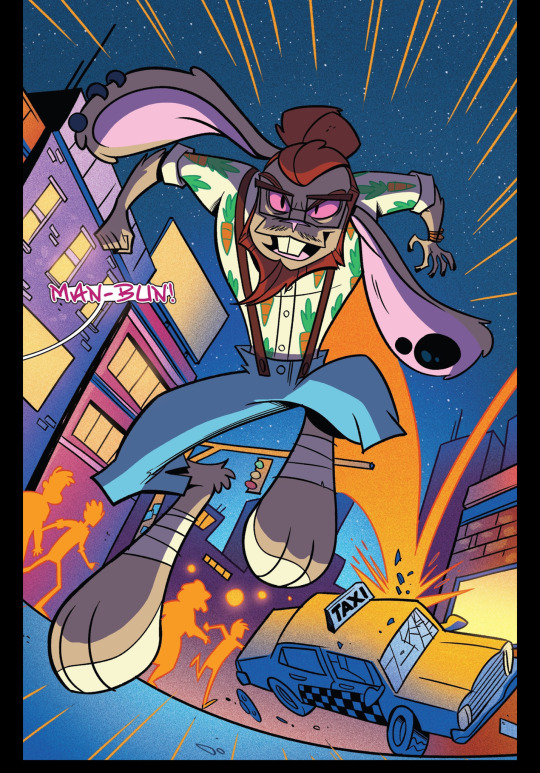
Chapter 9, How It's Made, APRIL O'NEIIIIILLLL, Harvey Hokum, Warren Stone and Kendra are referenced, "Operation Blue Suede Shoes" contains the title of a song, a reference to how in the show there are several similar code-names used for the characters ("Purple Rain" for Donnie, "Yellow Submarine" for April, etc.) Leo says that Mikey has empathy amplified, a reference to the fanfiction of the same name written by @filsa-mek on AO3.
Chapter 10, the boys watch "Wallace and Gromit: Curse of the Were-Rabbit". Leo promises to never leave Raphael alone and to always find him. Raph offers several scenarios that actually happen in the future where Leo searches for Raph - sewer monsters (a reference to the episode Man Vs. Sewer), getting captured by bad guys (the episode Bug Busters), and aliens attacking (the events of the film). The chapter as a whole is also based off of a few sketches I made - one of which shows the boys watching the film with Splinter, and one where Raph has a bad dream and wakes up to seeing he hurt Leo, who offers to help and gets the bros together for a turtle pile.
Chapter 11, the episode is heavily inspired by an episode of the audio drama series Adventures in Odyssey, specifically the episode "Mandy's Debut". The line "Wow, the shortcake of death" is a reference taken from said same episode! During Leo's flashback, a reference to the meme "She knocked that smug look off my face, but fourtunately I had a smaller smug look underneath" when Leo takes off his sunglasses to reveal a cooler pair of sunglasses underneath. Leo and Raph make a note to the fact that Leo is not the eldest in this universe.
Chapter 12, Raph, Leo, and Mikey teach April a game they play in the episode "Late Fee". When using sign language, Donnie tells Leo to "Stop yelling at me", which is inspired by a moment in Spy Kids 4. April introduces Raph to Ghostbear's starting career. Mikey repeats a line from the episode "Bug Busters", which is "Remind me not to ask questions anymore." Mikey uses the phrase "hydrate or die-drate", which is taken from a meme but is also something I say constantly as well. When in the Hidden City, Splinter hears people calling out to customers, one uses the lyrics to the Fairly Odd Parents' theme song, another is selling Mary Poppins' umbrella, a third is selling the three mystery journals from Gravity Falls, the fourth is selling Cinderella's glass slippers, and the last one is selling the Stanley Parable bucket of reassurance. Ochimizu is a Japanese mythical elixir of eternal life. The introduction and origins of Loathsome Leonard and the Mud Dogs. Malicious Mickey uses the "creepy doctor" line from "Stuck on You".
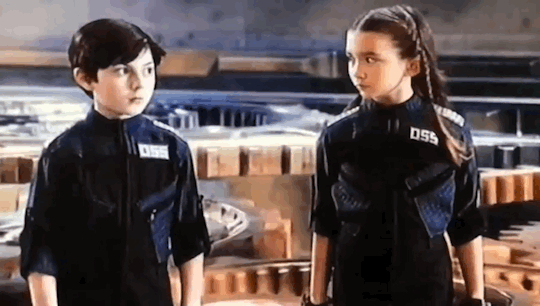
Chapter 13, Donnie delirium is directly based off of my own experiences with delirium, as well as his and Leo's conversation about whether or not Leo would miss him when he dies (which was an actual conversation I had with my mother when I was sick with croup as a little girl). The second half of that conversation was adapted from a scrapped fic called "The Kids Are All Dying". Donnie references the song "Big Yellow Taxi". The seven-tailed fox comes from Japanese folklore, but specifically this one was a reference to Naruto! Mikey sings the first line of the "Wonderfilled" song by Owl City. The secret ingredient being a discontinued soda was inspired by the ending of the musical "Be More Chill". The toad yokai becomes Heinous Green.
Short story, in the illustration you can see several signatures and sketches on Leo's cast, such as Raph signing "Mad Dawgs" and Mikey drawing his stickers. On the wall behind Leo is an eye exam that has the words "RISE" and "PHOEBE" on it. There's also a computer monitor in the back with Leo's vitals on it, as well as a notification about the trackers, and a list of all Hamatos Donnie tagged.
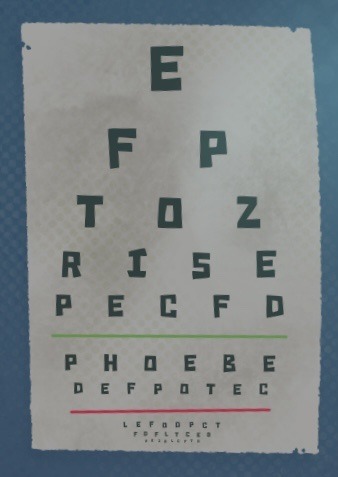
I will update more when I post new chapters... ;)
#rise of the teenage mutant ninja turtles#rottmnt#tutant meenage neetle teetles#rottmnt raph#rottmnt leo#rottmnt donnie#rottmnt mikey#rottmnt fic#rottmnt fanfic#fanfiction#i understood that reference#reference#easter eggs#hidden refrences#did you catch that?
81 notes
·
View notes
Text
Zodiacs existences
My first idea is to do my project on zodiac signs and how they came into existence and how I can portray that through animation.
Ø Scorpio – Scorpio vs Orion - Orion was a giant hunter. The primary story goes that Orion was the lover of Eos (Greek mythology), the goddess of the dawn, and bragged about his conquests with her. This of course, made her angry. Then Orion bragged about how he was such a great hunter that he was going to kill every creature on earth.
Normally in Greek myths this is the point where Artemis, the Greek hunting goddess, would take offense to anyone claiming superiority in hunting skills, and cut them down to size. The only thing was that Artemis had a big-time crush on Orion and found him charming. Her brother, Apollo, the sun god, did not find this claim quite so amusing, as he was also the god of the animal herds. Neither did Gaia, Greek mythology's great earth goddess, for obvious reasons. So, Apollo and Gaia talked and decided that it was time for Orion to go, so Gaia created a giant scorpion to hunt the hunter. Orion pretty much knew he was screwed, so he ran, and Scorpio chased him. Zeus had been watching the whole thing and put both Orion and Scorpio in the sky as constellations but placing them 180 degrees apart so that they wouldn't keep fighting in the heavens.
Ø Leo – Hercules vs Leo - In the first of his trials Hercules (Greek mythology) is tasked with finding and killing the Nemean Lion, an enormous and powerful lion whose hide is impenetrable. Hercules doesn't know this however and shoots the Nemean Lion with arrows, which do nothing but make it mad. Being Hercules, he decides to make a mad dash at the Nemean Lion rather than run away. The lion runs into its cave, which has two entrances. Long story short, Hercules blocks off an entrance, rushes into the cave, hits the Nemean Lion over the head with his club hard enough to stun it, then proceeds to choke it to death with his bare hands. In order to prove his victory, Hercules is supposed to bring the pelt of the Nemean Lion back to King Eurystheus. Hercules tries to cut the pelt off the lion's body before realizing that it's still impenetrable. After trying a few different tactics, he finally figures out that the only thing that can cut the skin of the Nemean Lion is its own claws. Eventually he is able to use the claws to skin the lion. He brings the pelt back to Eurystheus but ends up keeping it to use as his own personal armour. Hera, who sent the Lion to Nemea in the first place, took pity on the creature (or perhaps felt guilty) for it getting hunted down and killed and allowed it to live amongst the stars, next to Selene, the moon goddess, who adored him.
Ø Taurus – Taurus and Persephone - According to this myth, the mythology of Taurus begins with a wandering bull known as Cerus. Cerus was a large and powerful bull who villagers were terrified of because of his tendency to trample their villages to pieces on a whim. He was owned by no one, and none of the farmers knew where he came from. Though he was not immortal, most people assumed him to be because of his sheer size and strength and the fact that despite all the destruction he caused nobody was ever able to stop him.
The bull is wild and out of control, choosing to follow his emotions on a whim. One day the Spring goddess Persephone finds him trampling through a field of recently bloomed flowers and goes to him. Though he cannot speak, he seems to understand her, and her presence calms him. They form a bond together, and the bull learns to behave himself. Persephone teaches the bull patience and how to use his strength wisely.
Every year in the spring when Persephone returns to the land, Cerus returns to the land to join her. She sits upon his back and he runs her through the fields, allowing her to set all the plants in bloom as they ride by. In the fall when Persephone returns to Hades, Cerus returns to the sky as the Taurus constellation.
Ø Pisces – Pisces and the monster - In this Greek myth, the monster Typhon descends upon Mount Olympus, threatening all the gods and goddesses, who flee from their home (with a couple key exceptions). As Typhon approaches, the goddess Aphrodite and her son Eros find themselves in need of escape. According to different versions of this legend, either Aphrodite and Eros turn into fish, two fish approach them and swim them away to safety, or they turn into fish AND two other fish take them to safety. One way or another, the two escape from Typhon thanks to two fish. These two fish were later honoured by being placed in the heavens as the constellation Pisces. It is for this reason that I tend to believe that there were two fish who were not Aphrodite and Eros, since during Typhon's assault on Mount Olympus, the other gods turned into animals as well, and were not turned into constellations.
PISCES AND CANCER LINK
Ø Cancer – cancer vs Vamari - When the god of monsters Typhon (Greek mythology) terrorized the gods of Olympus, Poseidon, along with most of the other gods, went into hiding. He left Crios in charge of protecting the sea nymphs, who were Poseidon's daughters. The crab took his role as protector very seriously and wouldn't let any of the sea nymphs outside of his reach. After a while, some of the sea nymphs became restless, and convinced that they were in no danger from Typhon, escaped into the open sea.
Crios could not chase them as he was charged with protecting the other sea nymphs, so he enlisted the help of the giant squid, Vamari. Little did he know that Vamari (whose name translates to "Vampire Squid") had ill intentions, and when he caught up to the sea nymphs, he devoured them. When Vamari returned to Crios, he told the crab that despite a valiant effort, he could not find any of the missing sea nymphs. Crios knew that he was lying and attacked him. They battled for hours until the crab finally won. But he had sustained such bad injuries that he was terribly crippled from that time forward. Since he was immortal, though, he could not die, but had to live in pain. When Poseidon returned, he saw the bravery that the crab had shown and relieved him of his pain, but not his immortality, by placing him in the sky as the constellation Cancer.
0 notes
Text
New Post has been published on Mythology.net
New Post has been published on http://mythology.net/greek/greek-creatures/hydra/
Hydra
What is the Hydra?
The Hydra is an immortal, many-headed snake who haunted the swamps around Lake Lerna in ancient Greece. Although the monster claimed hundreds of victims, it is most famous for its battle with the hero Heracles.
Characteristics
Physical Description
The Hydra was literally multiple times more ferocious than its closest relative: the snake. Not only was this swamp-dwelling monster larger than any known snake, it had somewhere between six and one hundred heads!
Each of the Hydra’s heads was supported by a long neck, so the heads could coil around each other or fan out and attack challengers from every angle. Eventually, all those necks welded together into a fat tail, which trailed along the ground behind the monster. Some show the tail forking at the end into two or more small tails.
Personality
The Hydra had a nasty personality to match its horrid appearance. From birth, the goddess Hera trained the monster to attack and destroy anything that fell beneath its gaze. It ravaged innocent villages around its home, Lake Lerna, devouring hundreds of victims.
When the Hydra wasn’t filling its stomach with human flesh, it slumbered in a deep swamp cave (which was rumored to be one of the entrances to the underworld). Only hunger or rage could draw the beast out of its lair; otherwise, it was mindless and lazy.
Special Abilities
It’s no mistake that Hera chose the Hydra as one of Heracle’s Eleven Tasks. This monster had powers that could easily send a hero to the underworld.
First, the Hydra’s blood was full of super-toxic poison. Some men died simply from approaching the beast’s lair and smelling its poisonous blood and breath. Even after the Hydra was slaughtered, its blood was used as a weapon that brought down many strong fighters.
Second, the Hydra was immortal and had regenerative abilities. The monster had one, immortal head, which was protected by the other, deadly heads that grew around it. If any of the mortal heads were cut off, two or more heads would sprout from the monster’s body to replace the loss. The beast could only be killed by cutting off the immortal head—a near impossible text.
Related Characters
The Hydra was the offspring of Greek’s two earliest monsters: Typhon, an immortal giant, and Echidna, half-woman and half-snake. Together, they gave the Hydra its immortality, monstrous shape, and evil disposition.
Hera, wife of Zeus, adopted the Hydra when it was a baby. She raised the creature with the intent of using it to destroy Heracles—finding a home for it, protecting it from harm, and nurturing its destructive impulses.
When Heracles finally encountered the Hydra, all Hera’s training was put to the test. The monster very nearly killed the hero. He only managed to kill it with the help of his quick-witted nephew, Iolaus.
Stories
Heracles vs. the Hydra
Heracles was the son of Zeus, but he wasn’t the son of Zeus’s wife, Hera. Shortly after Heracles was born, Hera found out about Zeus’s infidelity and demanded that he banish his son from Mt. Olympus. But even that punishment wasn’t enough for Hera. As she watched the golden boy grow into a young Greek hero, she grew angrier and angrier still.
When an oracle told Heracles that, to gain immortality, he must complete twelve impossible tasks, Hera saw a golden opportunity to get rid of the boy once and for all. She adopted the Hydra and began training it to be one of Greek’s most fearsome monsters—a monster that would be almost impossible to kill. Sure enough, slaying the Hydra became one of Heracles twelve tasks, much to Hera’s delight.
Heracles entered the Lernaean swamp with his mouth and nose covered in thick fabric, so that he wouldn’t breathe the monster’s poisonous scent. He crept to the cave around the Spring of Amymone, where the monster slept, and shot fiery arrows into it. After a few areas, the Hydra charged out of the cave, ready to tear its assailant to shreds. But Heracles was ready too. He began cutting off the Hydra’s heads as fast as he could. Though the monster shrieked in pain, the injuries were far from life-threatening. In fact, they only made the Hydra stronger, as several new heads grew to replace each one that was lost.
After a few minutes of bloody battle, Heracles realized that he could never defeat the Hydra alone. Desperate, he called to his nephew, Iolaus, who brought a torch and began burning the bloody stumps as fast as Heracles cut off the Hydra’s heads. The cauterized stumps prevented knew heads from growing.
When Hera saw that Heracles and Iolaus had found a way to kill her monster, she was so angry that she sent a giant crab to distract Heracles. He crushed this under his foot.
At last, Heracles hacked his way to the Hydra’s lone, immortal head. He cut this off with a golden sword, given to him by Athena, and buried it under a huge rock.
Despite the fact that he had slaughtered the horrible Hydra, some people claimed that Heracles had not completed the task because he had asked Iolaus for help.
The Hydra Avenged
After Heracles killed the Hydra, he dipped some of his arrows in the monster’s toxic blood. He used these arrows to kill new enemies, who didn’t stand a chance against the poison.
A centaur named Nessus was one of the enemies who Heracles killed with his poisonous arrows. As he lay dying, Nessus beckoned to Heracles’ wife and told her that his blood, spilled by her husband, could be used as a love charm that would make her husband faithful to her for life. In fact, Nessus’ blood was tainted with Hydra poison and had become a deadly weapon itself. Not knowing this, Heracles’ wife dipped his clothes in the blood and gave them to him to wear. As soon as the cloth touched Heracles’ skin, the Hydra’s poison began to burn his flesh—and it burned until the hero was dead. Thus, in the end, the Hydra claimed Heracles’ life in return for its own.
Cultural Representation
Origin
In writing, the Hydra first appears in Hesiod’s Theogony, which dates back to around 700 BCE. Paintings and pottery suggest that the Hydra’s legend might be even older than this, possibly rising from Sumerian, Babylonian, and Assyrian religions.
After Hesiod introduce the Hydra, it was embellished by the likes of Ovid, Seneca, Plato, and Virgil. Originally, the serpent had six heads, and none of them regenerated, but as the story grew in fame, the monster grew in horror.
Modern Appearances
Today, the Hydra is not well-known as a standalone character, but it is still the first monster that comes to mind when people think of “Hercules” and his trials.
Interestingly, the Hydra—an unnatural creature—has made a name for itself in the natural sciences. In astronomy, constellations and technological tools have been named after the monster, and in taxonomy, a whole genus of tentacled sea creatures bear the monster’s name.
0 notes